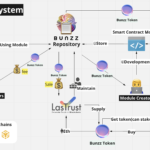Web3.py and Web3.js are two of the most popular web3 libraries used in the Ethereum ecosystem. They both provide a way for developers to interact with the Ethereum blockchain, but they have some significant differences. This article will compare the two libraries in depth and help you decide which one is best for your project.
A deeper dive into Web3.py and Web3.js
Web3.py is a Python library used to interact with the Ethereum blockchain. It is built on top of the popular web3.js library and provides a Pythonic interface for interacting with the Ethereum blockchain.
Web3.py is well-suited for projects built using Python and has a user-friendly API that is easy to use. The library also supports synchronous and asynchronous programming, allowing developers to choose the most appropriate method for their projects.
One of the main advantages of Web3.py is its easy-to-use API. The library has a simple and intuitive interface that makes it easy for developers to interact with the Ethereum blockchain. Web3.py provides JSON-RPC support, allowing developers to interact with the Ethereum blockchain using standard HTTP requests. This makes it easy to integrate Web3.py into existing projects, and it also makes it easy to test and debug your code.
On the other hand, Web3.js is a JavaScript library used to interact with the Ethereum blockchain. It is the most popular web3 library widely used in the Ethereum ecosystem. Web3.js provides a JavaScript API that is easy to use and well-suited for projects built using JavaScript. The library also supports synchronous and asynchronous programming, allowing developers to choose the most appropriate method for their projects.
One of the main advantages of Web3.js is its wide range of functionalities. The library supports contract deployment, contract interaction, and transaction management. Web3.js provides support for web3 extensions, such as MetaMask, which makes it easier to use web3 with browser-based applications. This makes Web3.js an ideal choice for building browser-based decentralized applications.
Features Comparison
| Feature | Web3.py | Web3.js |
| Language | Python | JavaScript |
| Ethereum Client Support | Geth, Parity, and Infura | Geth, Parity, and Infura |
| Asynchrony Support | Asynchronous | Both Synchronous and Asynchronous |
| Transaction Signing | Built-in support for signing transactions | Requires external library (e.g. ethereumjs-tx) |
| Popularity | Widely used in the Python community | Widely used in the JavaScript community |
| Error handling | Raise exceptions for error | Reject promise and pass error object |
| API | Pythonic and Object Oriented | Similar to web3.py but with JavaScript conventions |
| Installation | pip install web3 | npm install web3 |
Both web3.py and web3.js are libraries for interacting with the Ethereum blockchain; however, they have some important differences. web3.py is written in Python, and web3.js is written in JavaScript. Both support the same Ethereum clients (Geth, Parity, and Infura) and have similar functionality.
When it comes to the features, both libraries provide similar functionality. Both libraries support contract deployment, contract interaction, and transaction management. However, there are some differences between the two libraries regarding specific features.
Web3.py has better support for smart contract events, which allows developers to interact with contract events more easily. The library provides an easy-to-use interface for subscribing to contract events and supports filtering events based on specific criteria. This feature is useful for building decentralized applications that need to react to events on the Ethereum blockchain.
On the other hand, Web3.js has better support for web3 extensions, such as MetaMask. Web3.js provides an easy-to-use interface for interacting with web3 extensions and provides support for web3.eth, web3.eth.contract, and web3.eth.accounts, among others. This feature is useful for building browser-based decentralized applications that need to interact with the Ethereum blockchain.
Performance
| Performance | Web3.py | Web3.js |
| Execution Speed | slower | faster |
| Memory usage | higher | lower |
| Concurrency | less efficient | more efficient |
It can be challenging to compare the performance of web3.py and web3.js as it largely depends on the specific use case and the hardware it’s running on. However, web3.js has a slight advantage in execution speed, memory usage, and concurrency support. This is primarily because JavaScript is a more lightweight and faster language than Python.
JavaScript’s single-threaded nature allows it to handle multiple tasks simultaneously in a non-blocking way, while Python’s multi-threaded nature can lead to slower performance in concurrent operations.
It’s worth noting that the performance difference between the two libraries may be insignificant for small to medium-scale projects, but it could become more pronounced in large-scale projects.
When it comes to performance, both Web3.py and Web3.js are optimized libraries that provide similar performance. Both libraries have been designed to minimize the number of requests made to the Ethereum blockchain, which helps to reduce network latency and improve performance. Both libraries provide caching support, which helps reduce the number of requests made to the Ethereum blockchain and improve performance.
However, there are some slight differences in the performance of the two libraries. Web3.py relies on web3.js for some of its functionality, which can cause some additional overhead and impact performance, but in most cases, the impact is negligible. On the other hand, Web3.js being a native JavaScript library, runs directly in the browser, which can provide a slight performance advantage over Web3.py.
Community and Resources
When it comes to community and resources, Web3.js has a significant advantage over Web3.py. Web3.js is the most widely used web3 library, and it has been around for longer. As a result, it has a much larger community and more resources available for developers. This includes tutorials, documentation, and examples, which makes it easier for developers to learn and work with Web3.js. More developers are familiar with Web3.js and can provide help and support.
On the other hand, Web3.py is a newer library with a smaller community and fewer resources available. The community around Web3.py is growing, and more resources are becoming available. The Python community is large and has a lot of resources available, which can help developers working with Web3.py.
Web3.py and Web3.js are well-optimized libraries that provide similar performance. However, Web3.js has a slight performance advantage due to its native JavaScript implementation. Regarding community and resources, Web3.js has a significant advantage over Web3.py, but the community around Web3.py is growing, and more resources are becoming available.
Ultimately, the choice between the two libraries will depend on your specific needs and the programming language you are comfortable with.
Conclusion
In conclusion, Web3.py and Web3.js are excellent libraries for interacting with the Ethereum blockchain. Both libraries provide similar functionality for contract deployment, contract interaction, and transaction management.
The choice between the two libraries will depend on the specific needs of your project and the programming language you are comfortable with. If you are working on a Python project, then Web3.py is the better choice, and if you are working on a JavaScript project, then Web3.js is the better choice.
Whatever choice you make, you can deploy and interact with smart contracts in minutes with Bunzz using Web3.py or Web3.js. Get started here







